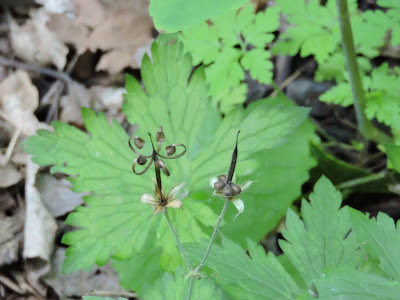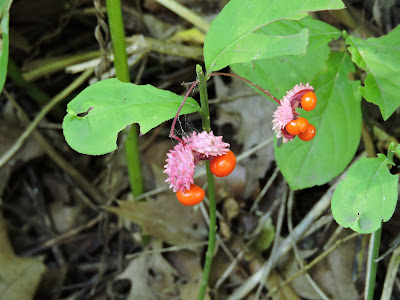As you get closer to the bridge, you leave the cool of the woods to enter a meadow where I have seen bald eagles soaring overhead and bluebirds sitting in the oak tree. You can continue west on the path or cross the bridge where the path will take you through a conservation area. Most of the year the river at this point is hidden until you actually cross onto the bridge. There is a sign before you step onto the bridge itself, which recognizes those who have contributed to making this a lovely path,and on it is the name of a friend's grandma. She was a feisty lady who lived life on her own terms, and leaves a legacy of strong and beautiful women. I was honored to know her for a short time and I often remember her when I walk here.
I have seen deer looking up at me, grazing in the meadow, and crossing the river in the twilight.
I have seen blue heron fish in the river, fly overhead, and sit on a tree limb to preen.
I saw a beautiful least bittern, less common around here, sit beneath the bridge.
I have seen small turtles on the rocks beside the river, and a grandpa snapping turtle sun on the pile of sticks and debris on the far shore. I was just as happy to admire him from a distance. He was huge!
A spring and summer constant on the bridge is the Red-winged blackbird, generally the male. A favorite nesting place is the small island below because of its dense covering of reeds. The mamas are busy in the nests, while father oversees all from the bridge and shouts encouragement.
I have enjoyed sightings of Hooded mergansers, Yellowlegs, and just recently, a Pied-bill grebe. Rare treats.
The list of amazing things that I have seen from the bridge is long and will probably merit more discussion at a later date, but the last two I want to mention are the beaver and the muskrat. Perhaps this seems an odd choice, but let me just say that I grew up in a big city, and these are animals that I had thought never to see in the wild.
From the bridge I saw them feeding,
playing and interacting as a family,
leaving evidence of their work, and even having a bath. My own private nature program!
I hope that the diversity of the wildlife That I see on the Grand River speaks to a general healthiness of the water and ecosystem. It will surely require our careful stewardship to maintain and improve.
The muskrat is much smaller than the beaver and more likely to be seen at any time of day on the river. I had always thought that its tail was round like a rat's, but not so. It is more like a blade, sharp on the edges and thicker in the middle, and they use it like a rudder. They live in burrows in the river bank which helps them to stay cool and of course keeps their favourite snacks handy.
I watched this muskrat one afternoon. He seemed to be doing some kind of muskrat triathlon where he swam a distance, climbed over a log or branch, then swam some more. The answer to this puzzling behaviour was that he was marking his territory with a secretion called "musk", and I will hazard a guess that this is the source of its familiar name of "musk"rat, which is much easier to say than its formal name of Ondatra zibethicus. If we take a short walk on the weird side, we can visit the White House in 1976 and listen in as Captain & Tennille sing "Muskrat Love" to the President and Queen Elizabeth. Another interesting, or not, fact, is that the song was to be called "Muskrat Candlelight". All this to say that muskrats have two or three litters per year, each with up to eight kits. Busy beavers, well, rats, but they were actually called musk beavers at one time, until this became confusing and found to not be actually accurate.
For most people, the bridge seems to be a just something necessary to get from one side of the river to the other; they ride across, or pass its length chatting, oblivious to the beauty of the river. Maybe there need to be benches, a gentle reminder to stop and watch the ebb and flow of the river, see the loveliness of its surroundings and all the life it supports. ...just a thought.
“A river seems a magic thing. A magic, moving, living part of the very earth itself.”
Laura Gilpin
















































